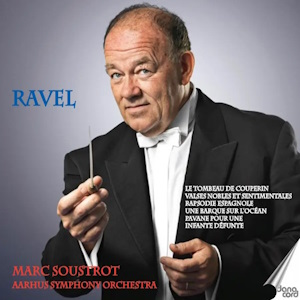
Maurice Ravel (1875-1937)
Le Tombeau de Couperin (1914-1917, orch.1919)
Valses nobles et sentimentales (1911, orch.1912)
Rapsodie espagnole (1907)
Un barque sur l’océan (1904-1905, orch.1906)
Pavane pour un enfant défunte (1899, orch.1910)
Aarhus Symphony Orchestra/Marc Soustrot
rec. 2023, Symphonic Hall, Aarhus, Denmark
Danacord DACOCD982 [67]
This enriching disc brings us a selection of Maurice Ravel’s orchestrations of his piano compositions, alongside the Rapsodie espagnole.
Ravel insisted that Le Tombeau de Couperin, a suite for solo piano, was “a tribute not so much to Couperin himself as to Eighteenth Century French music in general”. The six movements – Prélude, Fugue, Forlane, Rigaudon, Menuet and Toccata – were dedicated to friends killed in the First World War. Ravel then orchestrated four of them, omitting the Fugue and Toccata. The serene and charming Prélude sets the scene for the suite, yet even here there is an occasional slight edge to its progress. The playful Forlane may remind one of an antique dance, from an earlier generation of French composers. Ravel pays homage to classicism in the graceful Minuet. A folk dance, seen through twentieth-century eyes, underlies the lively and rhythmic Rigaudon.
The piano suite Valses nobles et sentimentales gets a rich orchestral arrangement. Ravel wrote that it was “clearly enough my intention to write a chain of valses in the style of Schubert”. He had been inspired by Franz Schubert’s Valses nobles D969 from 1827 and Valses sentimentales D779 from 1823-1824. He may have also been motivated by Franz Liszt’s Valse caprice after Schubert and Soirées de Vienne, and there are nods to Johann Strauss II. Each of eight waltzes has its own character and atmosphere, its contrasting moods, pace and rhythmic variation, always with the 3/4 time signature.
Rapsodie espagnole is the only piece here originally written for orchestra. Like Bizet, Chabrier and Debussy, Ravel paints an evocative picture of the Iberian Peninsula and its musical traditions. There are four movements. The sultry, shimmering Prélude à la nuit (très modéré) is followed by a vibrant dance from the Malaga region complete with castanets and Basque drum. Then there is a slow, smoky Habanera (assez lent et d’un rythme las). The Rapsodie closes with the festive Feria (assez animé) which paints a riotous fairground image. The masterful orchestration enhances the effect.
The ubiquitous Pavane pour une infante défunte again started as a piano solo. Ravel orchestrated it a decade later. This lovely number evokes a sense of melancholy with its elegant melody and delicate textures. The picturesque title alludes to an unnamed member of Spanish royalty, but Ravel insisted that he “simply liked the sound of these words and I put them there, c’est tout”. Interestingly, it was dedicated to the Princess Edmond de Polignac née Winnaretta Singer, a patron of the arts and heiress to the Singer sewing machine fortune.
Une barque sur l’océan is the third section of Ravel’s Miroirs. According to the liner notes, Ravel “paints the movement of the boat with the theme initially presented by the flute”. The marking Très souple de rythme leaves much scope to portray the “unpredictable swell of the ocean”. It is hard to imagine a better “impression of a very blue Mediterranean, with just a hint of a breeze stirring up wavelets”.
The Aarhus Symphony orchestra, based in the second-largest Danish city, was established in 1935. Since 1982, it has mostly performed at the Musikhuset in the centre of Aarhus. The sixty-five players also engage in chamber music recitals, take part in school concerts, and support the Danish National Opera.
As Danacord explains, French classical conductor Marc Soustrot, the current Chief Conductor of the Aarhus SO, has extensive expertise in major works from the classical and Romantic repertoire. His interpretations of French orchestral compositions are particularly noted. Soustrot served as the director of the Orchestre Philharmonique des Pays de la Loire in 1976-1994, and as the Generalmusikdirektor of the Beethoven Orchester Bonn in 1995-2003. His first album for Danacord contained Georges Bizet’s Symphony, Carmen Suite No. 1 and L’Arlésienne Suites (review ~ review).
The disc offers a delightful listening experience with a great recording, comprehensive documentation and excellent performances. It serves as a wonderful primer to some of Maurice Ravel’s essential orchestrations.
John France
Buying this recording via a link below generates revenue for MWI, which helps the site remain free



















